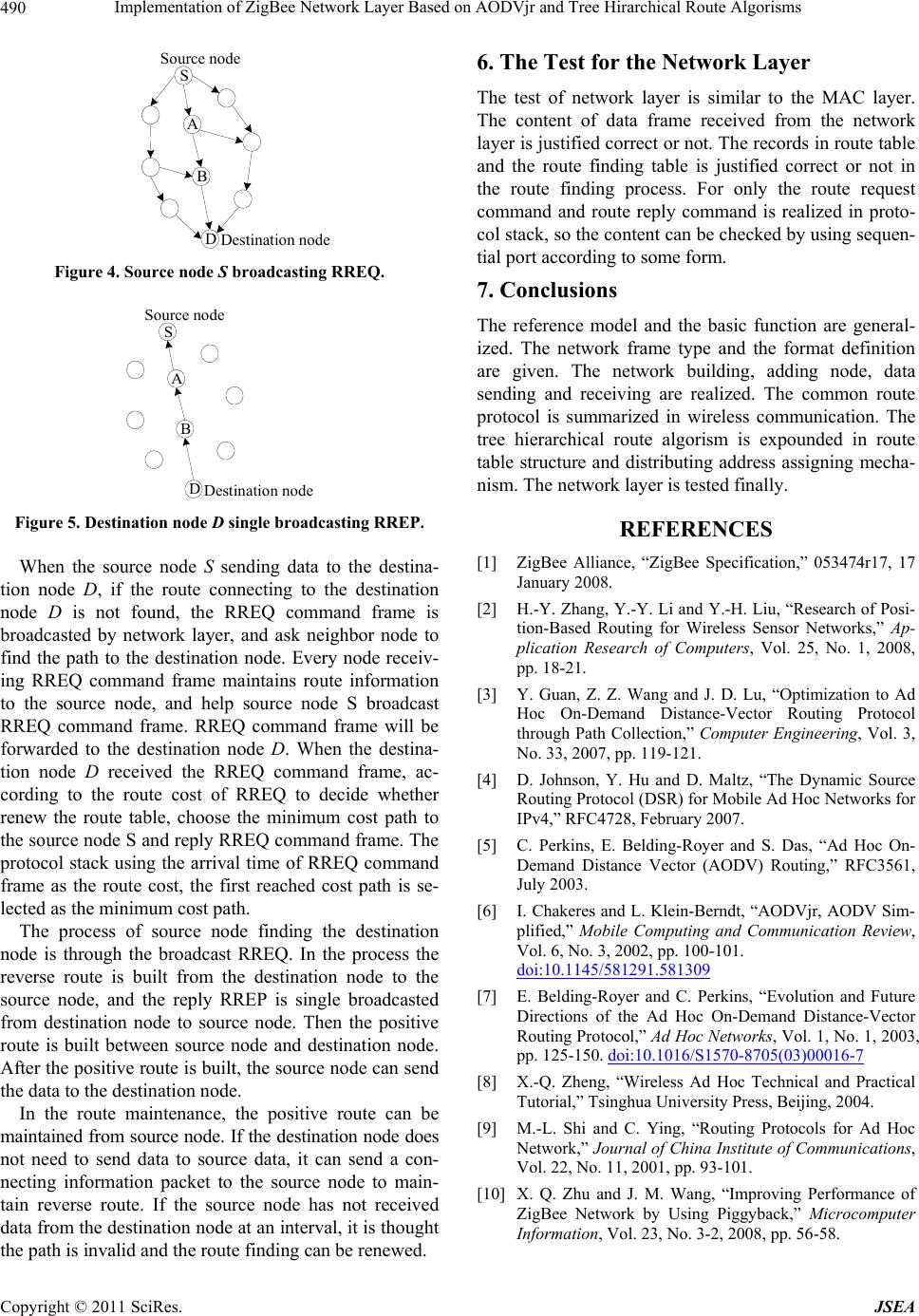
Implementation of ZigBee Network Layer Based on AODVjr and Tree Hirarchical Route Algorisms
Copyright © 2011 SciRes. JSEA
490
S
A
B
D
Sou rce node
Destination node
6. The Test for the Network Layer
The test of network layer is similar to the MAC layer.
The content of data frame received from the network
layer is justified correct or not. Th e record s in rou te table
and the route finding table is justified correct or not in
the route finding process. For only the route request
command and route reply command is realized in proto-
col stack, so the content can be checked by using sequen-
tial port according to some form.
Figure 4. Source node S broadcasting RREQ. 7. Conclusions
S
A
B
D
Source node
Destina ti on node
The reference model and the basic function are general-
ized. The network frame type and the format definition
are given. The network building, adding node, data
sending and receiving are realized. The common route
protocol is summarized in wireless communication. The
tree hierarchical route algorism is expounded in route
table structure and distributing address assigning mecha-
nism. The network layer is tested finally.
Figure 5. Destination node D single broadcasting RREP. REFERENCES
[1] ZigBee Alliance, “ZigBee Specification,” 053474r17, 17
January 2008.
When the source node S sending data to the destina-
tion node D, if the route connecting to the destination
node D is not found, the RREQ command frame is
broadcasted by network layer, and ask neighbor node to
find the path to the destination node. Every node receiv-
ing RREQ command frame maintains route information
to the source node, and help source node S broadcast
RREQ command frame. RREQ command frame will be
forwarded to the destination node D. When the destina-
tion node D received the RREQ command frame, ac-
cording to the route cost of RREQ to decide whether
renew the route table, choose the minimum cost path to
the source node S and r eply RREQ command frame. The
protocol stack using the arrival time of RREQ command
frame as the route cost, the first reached cost path is se-
lected as the minimum cost path.
[2] H.-Y. Zhang, Y.-Y. Li and Y.-H. Liu, “Research of Posi-
tion-Based Routing for Wireless Sensor Networks,” Ap-
plication Research of Computers, Vol. 25, No. 1, 2008,
pp. 18-21.
[3] Y. Guan, Z. Z. Wang and J. D. Lu, “Optimization to Ad
Hoc On-Demand Distance-Vector Routing Protocol
through Path Collection,” Computer Engineering, Vol. 3,
No. 33, 2007, pp. 119-121.
[4] D. Johnson, Y. Hu and D. Maltz, “The Dynamic Source
Routing Protocol (DSR) for Mobile Ad Hoc Networks for
IPv4,” RFC4728, February 2007.
[5] C. Perkins, E. Belding-Royer and S. Das, “Ad Hoc On-
Demand Distance Vector (AODV) Routing,” RFC3561,
July 2003.
[6] I. Chakeres and L. Klein-Berndt, “AODVjr, AODV Sim-
plified,” Mobile Computing and Communication Review,
Vol. 6, No. 3, 2002, pp. 100-101.
doi:10.1145/581291.581309
The process of source node finding the destination
node is through the broadcast RREQ. In the process the
reverse route is built from the destination node to the
source node, and the reply RREP is single broadcasted
from destination node to source node. Then the positive
route is built between source node and destination node.
After the positive route is built, the sour ce node can send
the data to the destination node.
[7] E. Belding-Royer and C. Perkins, “Evolution and Future
Directions of the Ad Hoc On-Demand Distance-Vector
Routing Protocol,” Ad Hoc Networks, Vol. 1, No. 1, 2003,
pp. 125-150. doi:10.1016/S1570-8705(03)00016-7
[8] X.-Q. Zheng, “Wireless Ad Hoc Technical and Practical
Tutorial,” Tsinghua University Press, Beijing, 2004.
In the route maintenance, the positive route can be
maintained from source node. If the destination node does
not need to send data to source data, it can send a con-
necting information packet to the source node to main-
tain reverse route. If the source node has not received
data from the destination node at an interval, it is thought
the path is invalid and the route finding can be renewed.
[9] M.-L. Shi and C. Ying, “Routing Protocols for Ad Hoc
Network,” Journal of China Institute of Communications,
Vol. 22, No. 11, 2001, pp. 93-101.
[10] X. Q. Zhu and J. M. Wang, “Improving Performance of
ZigBee Network by Using Piggyback,” Microcomputer
Information, Vol. 23, No. 3-2, 2008, pp. 56-58.